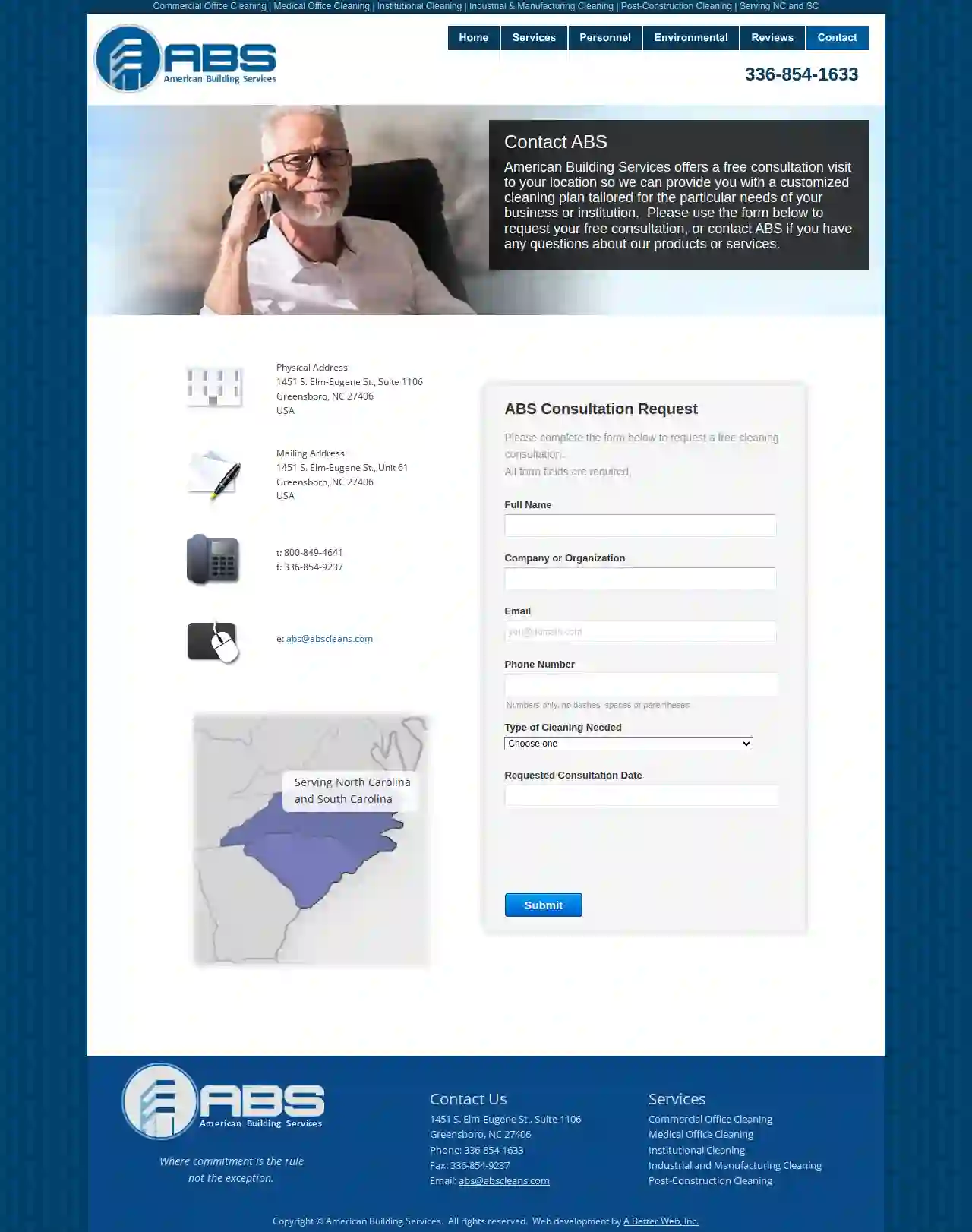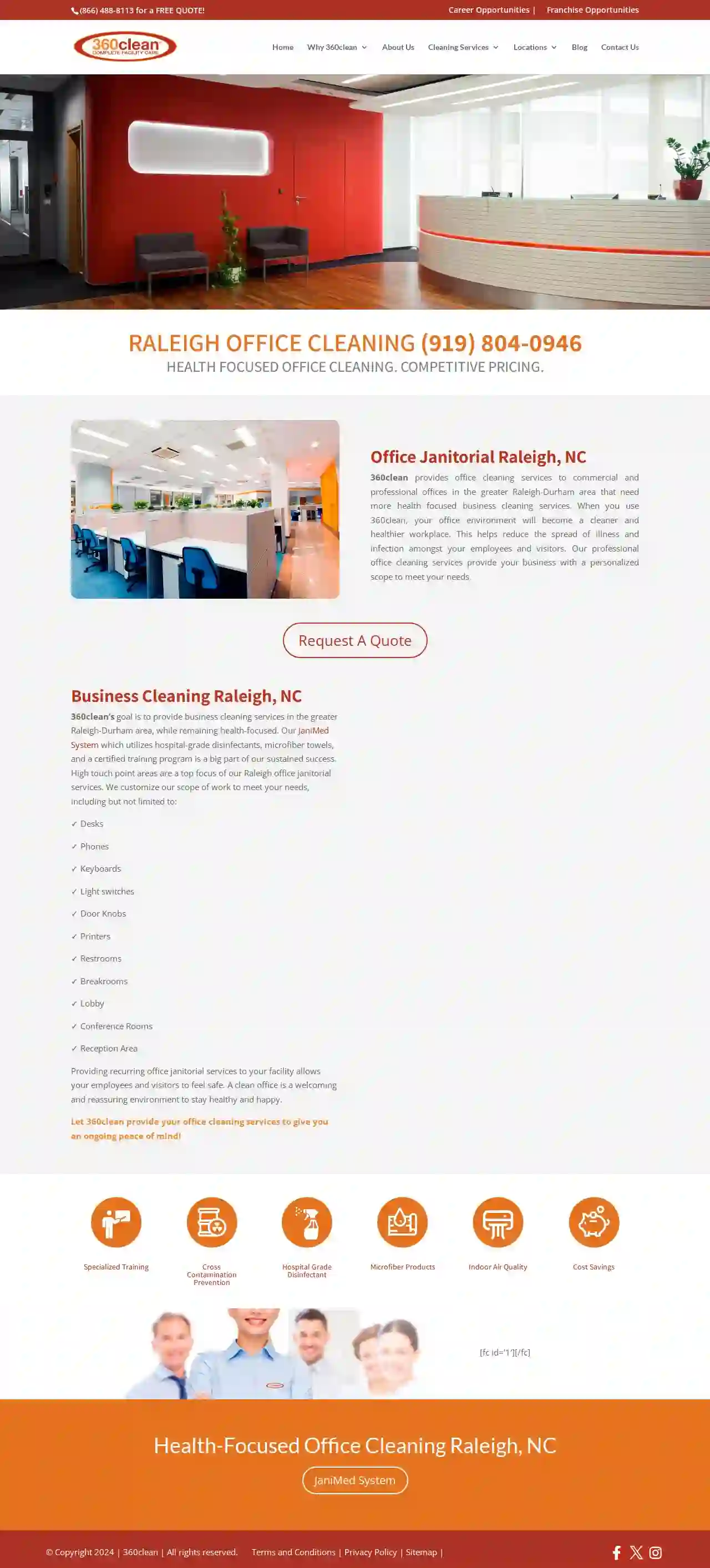Cleaning Services Ahoskie
Best Cleaning in Ahoskie
Receive up to 3 Cleaning Services quotes for your project today! Compare profiles, reviews, accreditations, portfolio, etc... and choose the best service.

American Building Service
42 reviewsSuite 1106, 1451 S. Elm-Eugene St., Greensboro, 27406, USAt American Building Services, we offer a wide range of cleaning services tailored to meet the specific needs of our clients. With a commitment to providing cost-effective solutions, we establish trusting relationships built on personal service. Our team of experienced professionals is dedicated to ensuring the cleanliness and safety of your facility, whether it's a commercial office, medical facility, institution, or industrial and manufacturing site. We also provide post-construction cleaning services to ensure your newly built or renovated space is spotless and ready for occupancy.
- Services
- Why Us?
- Gallery
Get Quote
Merry Maids of Fayetteville
4.445 reviewsFayetteville, US- Services
- Why Us?
Get Quote
TC Services
4.878 reviewsGreenville, US- Services
- Why Us?
Get Quote
CCR Elite - Construction, Commercial & Residential Cleaning
4.98 reviewsJacksonville, US- Services
- Why Us?
Get Quote- Ac
Acme Janitor & Chemical Inc
4.923 reviewsFayetteville, US- Services
- Why Us?
Get Quote - Ec
Ecosystems Inc.
3.45 reviewsGastonia, US- Services
- Why Us?
Get Quote 
360clean
52 reviewsRaleigh, US- Services
- Why Us?
Get Quote
Enviro-Master of Charlotte
5426 reviewsCharlotte, US- Services
- Why Us?
Get Quote
A-1 Supply Co
4.625 reviewsFayetteville, US- Services
- Why Us?
Get Quote
AVEX
4.932 reviewsHickory, US- Services
- Why Us?
Get Quote
Over 60,241+ Janitorial Businesses on our platform
Our janitorial companies operate in Ahoskie and surroundings!
CleaningMatch has curated and vetted the Best Janitorial Businesses arround Ahoskie. Find a top & reliable pro today.
Frequently Asked Questions About Cleaning Services
- Communicate clearly: Before the cleaning, communicate your expectations and any specific cleaning requirements. Provide a list of areas you want them to focus on or any tasks you want them to prioritize.
- Provide access: Ensure the cleaners have access to all the areas that need cleaning. Unlock doors, clear clutter, and provide any necessary instructions.
- Walk through after cleaning: Once the cleaning is complete, do a walk-through with the cleaners to inspect their work. Address any concerns or areas that need attention.
- Provide feedback: Give the cleaning service feedback on their performance. Let them know what you were happy with and any areas they can improve.
- Build a relationship: Establish a good relationship with the cleaning service by communicating openly, treating them with respect, and providing clear instructions.
- Cleaning: Removing dirt, dust, and debris from surfaces using soap or detergent and water. It improves the appearance and removes visible contaminants.
- Sanitizing: Reducing the number of bacteria on surfaces to a safe level. It uses chemical disinfectants or heat to kill or inactivate bacteria.
- Disinfecting: Killing or inactivating most disease-causing microorganisms on surfaces. It uses stronger chemical disinfectants than sanitizing and targets a wider range of pathogens.
- Clean Pet Bedding: Wash pet bedding regularly in hot water to remove odors and bacteria.
- Vacuum Thoroughly: Vacuum carpets, rugs, and upholstery frequently using a vacuum cleaner with a pet hair attachment.
- Enzyme Cleaners: Use enzyme cleaners specifically designed for pet odors. These cleaners break down the odor-causing molecules.
- Baking Soda: Sprinkle baking soda on carpets and upholstery, let it sit for a few hours, then vacuum. Baking soda absorbs odors.
- Air Fresheners: Use air fresheners or diffusers to mask odors temporarily.
- Professional Cleaning: For persistent odors, consider hiring a professional cleaning service specializing in pet odor removal.
- Experience and a proven track record: Choose companies with a solid history of providing quality cleaning services.
- Positive customer reviews and testimonials: Check online reviews and ratings to gauge customer satisfaction.
- Licensed and insured professionals: Ensure the company has the necessary licenses and insurance to protect you from liability.
- Clear and transparent pricing: Obtain detailed quotes and compare prices from multiple companies.
- Good communication and responsiveness: Choose a company that communicates clearly, responds promptly, and addresses your concerns.
How can I make sure my cleaning service does a good job?
Clear communication, a thorough inspection, and constructive feedback are key to getting the best results from your cleaning service.
What is the difference between cleaning, sanitizing, and disinfecting?
Cleaning is usually the first step, followed by sanitizing or disinfecting depending on the level of hygiene required.
How do I get rid of pet odors in my home?
Regular cleaning, enzyme cleaners, and baking soda are effective methods for eliminating pet odors and maintaining a fresh-smelling home.
How do I find a good cleaning service?
Utilize online directories like CleaningMatch to find and compare qualified cleaning services in your area.
How can I make sure my cleaning service does a good job?
- Communicate clearly: Before the cleaning, communicate your expectations and any specific cleaning requirements. Provide a list of areas you want them to focus on or any tasks you want them to prioritize.
- Provide access: Ensure the cleaners have access to all the areas that need cleaning. Unlock doors, clear clutter, and provide any necessary instructions.
- Walk through after cleaning: Once the cleaning is complete, do a walk-through with the cleaners to inspect their work. Address any concerns or areas that need attention.
- Provide feedback: Give the cleaning service feedback on their performance. Let them know what you were happy with and any areas they can improve.
- Build a relationship: Establish a good relationship with the cleaning service by communicating openly, treating them with respect, and providing clear instructions.
Clear communication, a thorough inspection, and constructive feedback are key to getting the best results from your cleaning service.
What is the difference between cleaning, sanitizing, and disinfecting?
- Cleaning: Removing dirt, dust, and debris from surfaces using soap or detergent and water. It improves the appearance and removes visible contaminants.
- Sanitizing: Reducing the number of bacteria on surfaces to a safe level. It uses chemical disinfectants or heat to kill or inactivate bacteria.
- Disinfecting: Killing or inactivating most disease-causing microorganisms on surfaces. It uses stronger chemical disinfectants than sanitizing and targets a wider range of pathogens.
Cleaning is usually the first step, followed by sanitizing or disinfecting depending on the level of hygiene required.
How do I get rid of pet odors in my home?
- Clean Pet Bedding: Wash pet bedding regularly in hot water to remove odors and bacteria.
- Vacuum Thoroughly: Vacuum carpets, rugs, and upholstery frequently using a vacuum cleaner with a pet hair attachment.
- Enzyme Cleaners: Use enzyme cleaners specifically designed for pet odors. These cleaners break down the odor-causing molecules.
- Baking Soda: Sprinkle baking soda on carpets and upholstery, let it sit for a few hours, then vacuum. Baking soda absorbs odors.
- Air Fresheners: Use air fresheners or diffusers to mask odors temporarily.
- Professional Cleaning: For persistent odors, consider hiring a professional cleaning service specializing in pet odor removal.
Regular cleaning, enzyme cleaners, and baking soda are effective methods for eliminating pet odors and maintaining a fresh-smelling home.
How do I find a good cleaning service?
- Experience and a proven track record: Choose companies with a solid history of providing quality cleaning services.
- Positive customer reviews and testimonials: Check online reviews and ratings to gauge customer satisfaction.
- Licensed and insured professionals: Ensure the company has the necessary licenses and insurance to protect you from liability.
- Clear and transparent pricing: Obtain detailed quotes and compare prices from multiple companies.
- Good communication and responsiveness: Choose a company that communicates clearly, responds promptly, and addresses your concerns.
Utilize online directories like CleaningMatch to find and compare qualified cleaning services in your area.